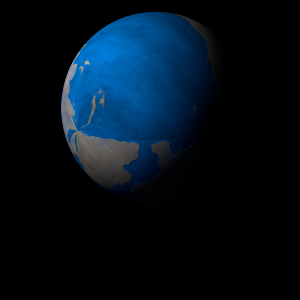|
|
Space Astro
|
Info for exoplanet "Ganyo"
| Scientific (actual) data |
|---|
| Planet | Sand 178 b |
| Planet status | Confirmed |
| Mass sini | 10.4 |
| Orbital period | 123.93 |
| Orbit eccentricity | 0.41 |
| Discovered | 2021 |
| Updated | 2022-02-08 |
| K | 804 |
| Publication | Published in a refereed paper |
| Detection type | Radial Velocity |
| Mass detection type | Radial Velocity |
| Star name | Sand 178 |
| Right ascension | 194.59° |
| Declination | 26.5° |
| Mag v | 14 |
| Star distance | 58.76 |
| Star sp type | M3 |
| Wikipedia article | Sand 178 b |
Back
| |
| Fictional info (?) |
|---|
| Suggested name | Ganyo |
| Planet type | Cold planet |
| It has the longest rotation period (445 days) of any planet in its solar system and rotates in the opposite direction to most other planets.
It is the coldest planetary atmosphere in its solar system, with a minimum temperature of 25°K (-248°C), and has a complex, layered cloud structure with methane thought to make up the lowest clouds, and carbon dioxide the uppermost layer of clouds. This cold planet is named after the deity Ganyo, the god of good fortune.
There are ongoing investigations assessing the past habitability potential of Ganyo, as well as the possibility of extant life. Liquid water cannot exist on the surface of Ganyo due to low atmospheric pressure, which is less than 4 percent of Bosa's, except at the lowest elevations for limited periods.
Observations from Earth have shown seasonal change and increased weather activity as Ganyo approached its equinox 6 years ago.
The horrible surface is inhabitated by dangerous ultra advanced herbivores, the "Hemeabyu Kumu", that feed in the forest by seeking anything they find. The Hemeabyu Kumu are not related to Pamehya Ryu and have 8 tentacles and vary in size from 60 to 150 meters. They can live at temperatures from 150 to 200°C and even near-vacuum which is common near the poles. |
| Estimated population | 29000000 |
| Atmosphere | Carbon dioxide | 85% |
| Methane | 7.6% |
| Water | 6.4% |
| Oxygen | 0.3% |
| Atmospheric pressure | 8 bar |
 |
| No known satellites |
| Google search for Ganyo |
|
Website by Joachim Michaelis
|
|
|
|